
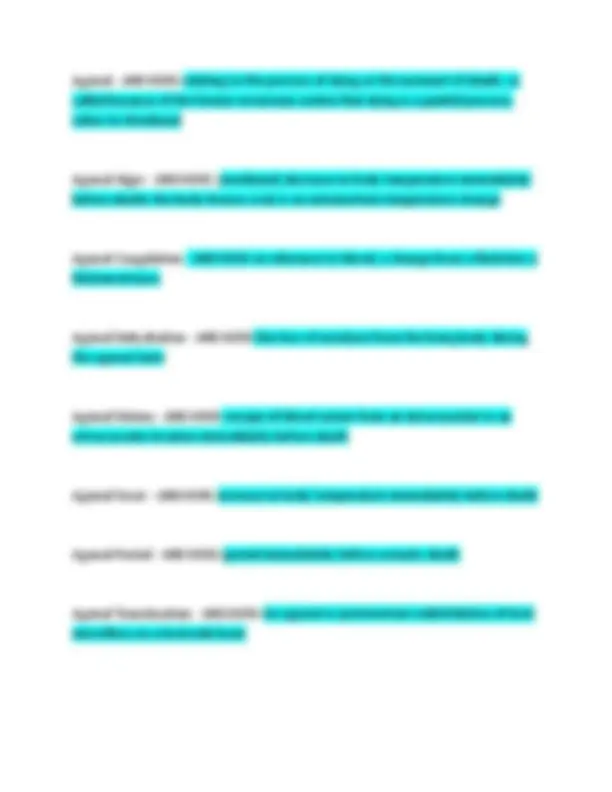
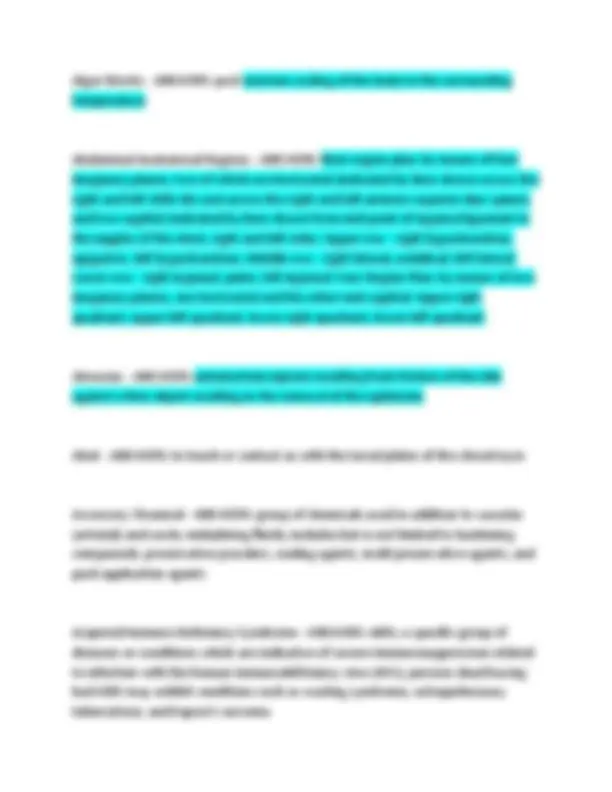
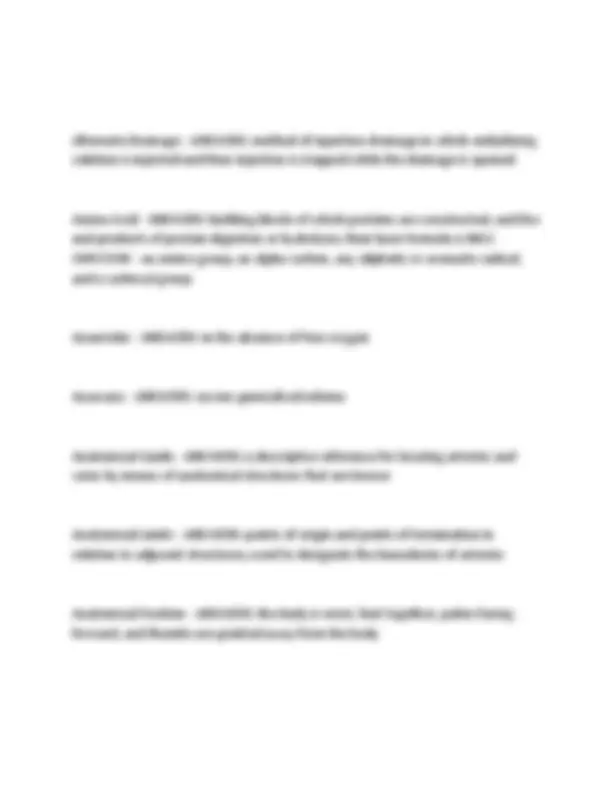
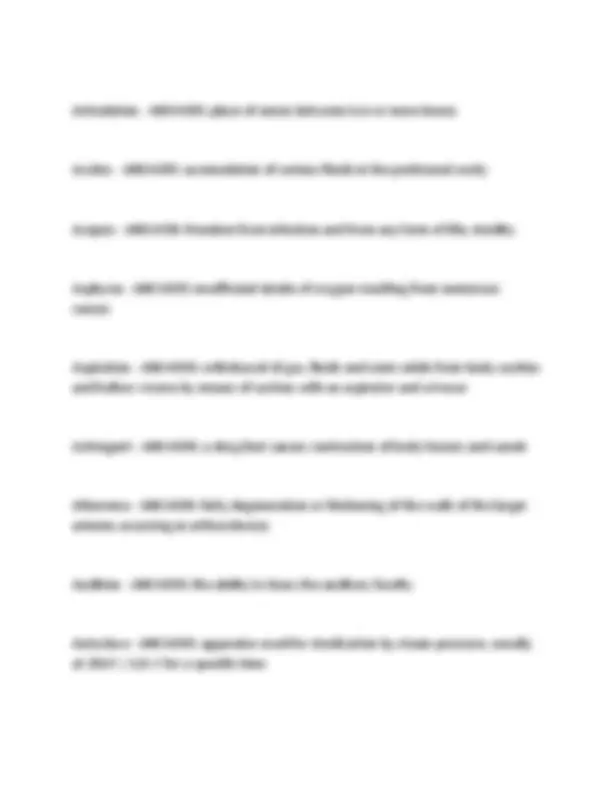
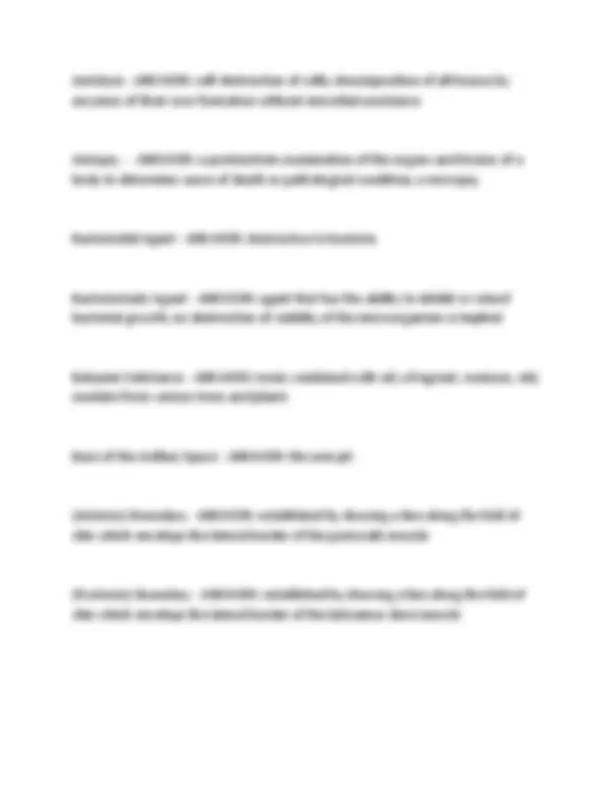
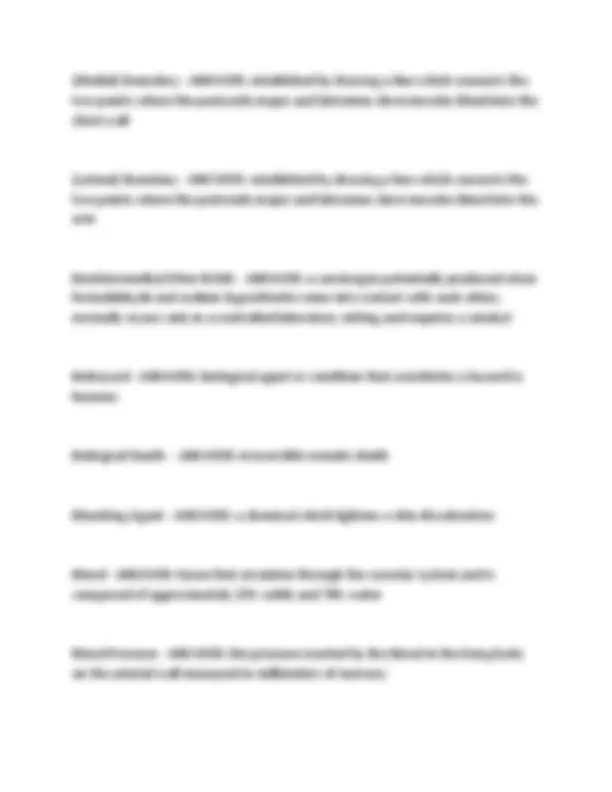
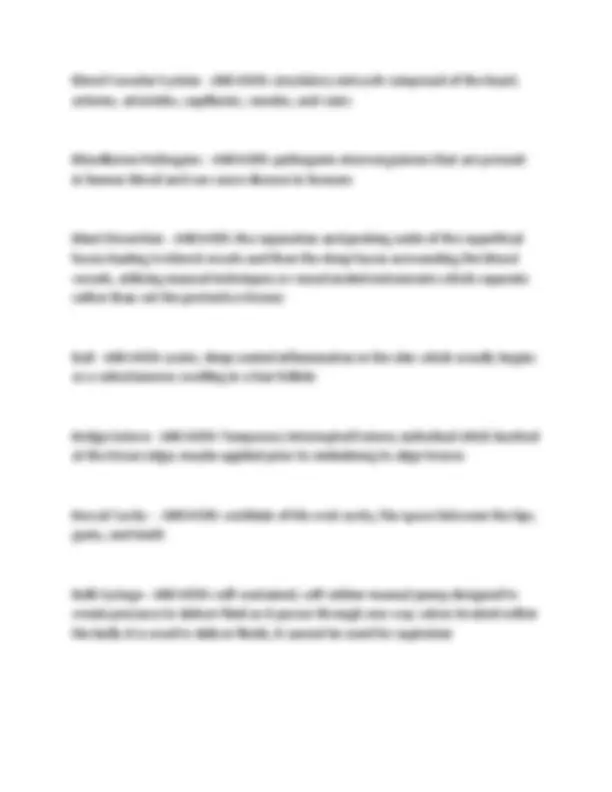
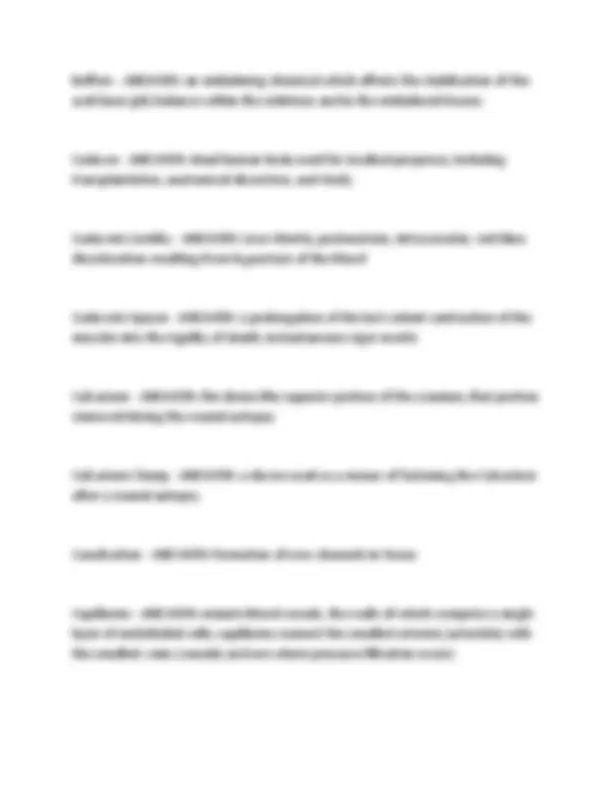
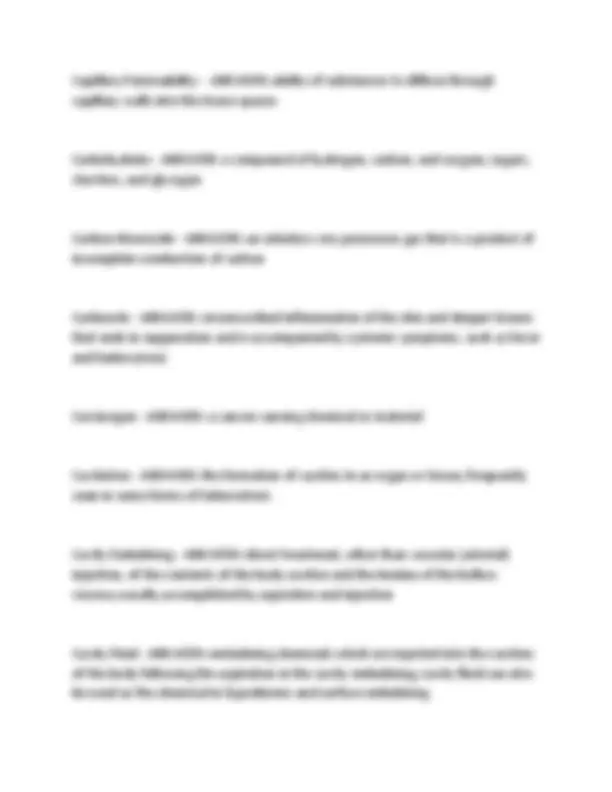
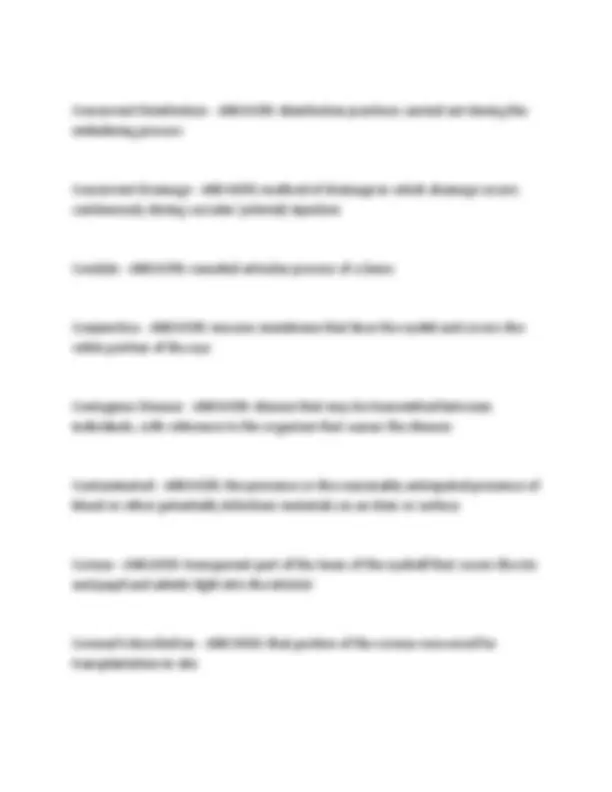
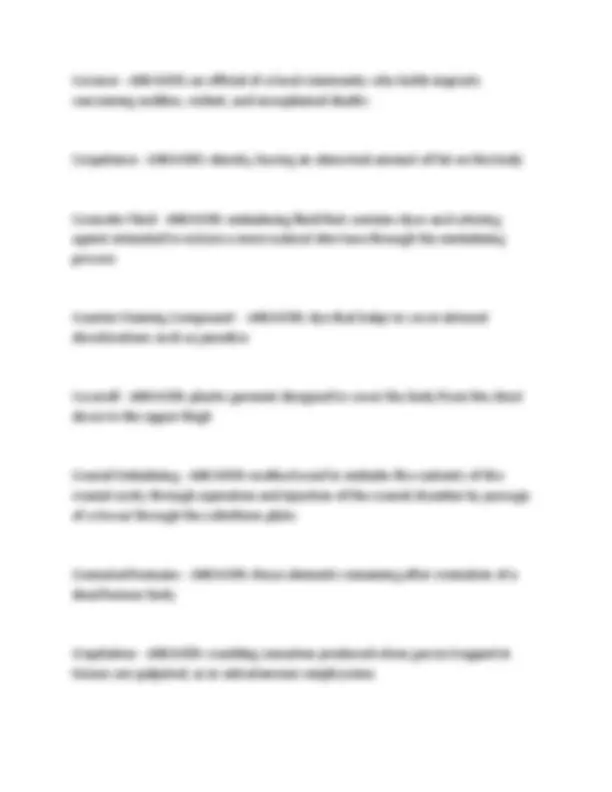
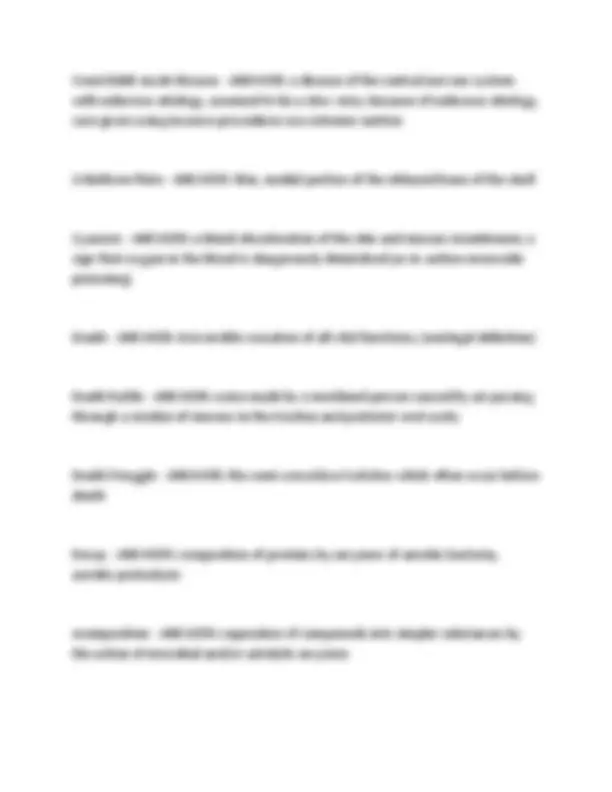
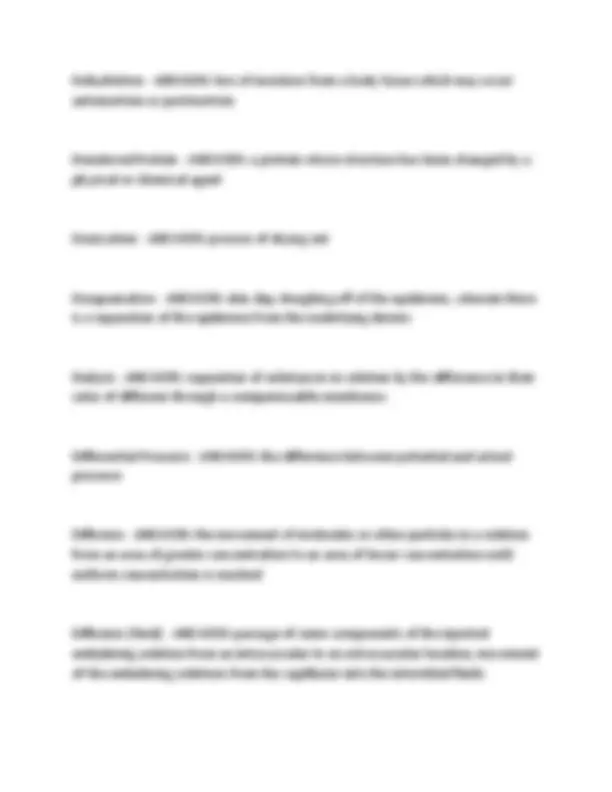
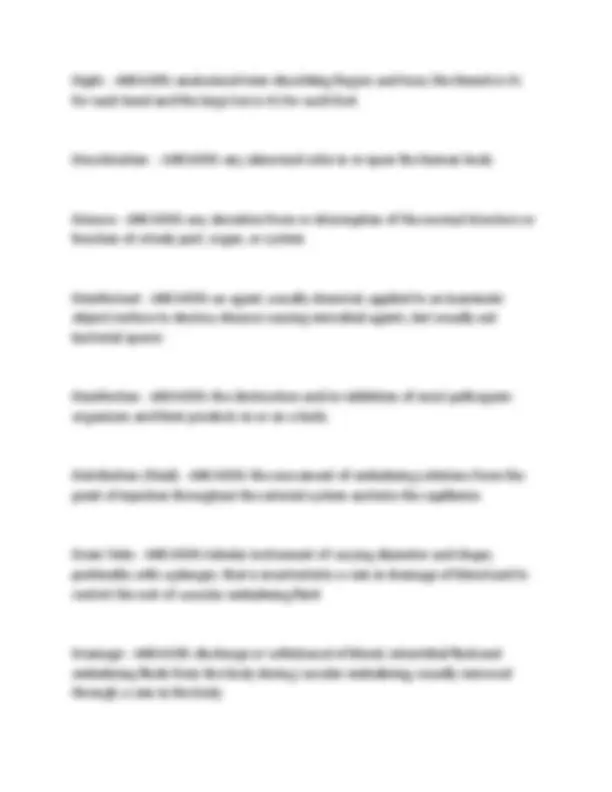
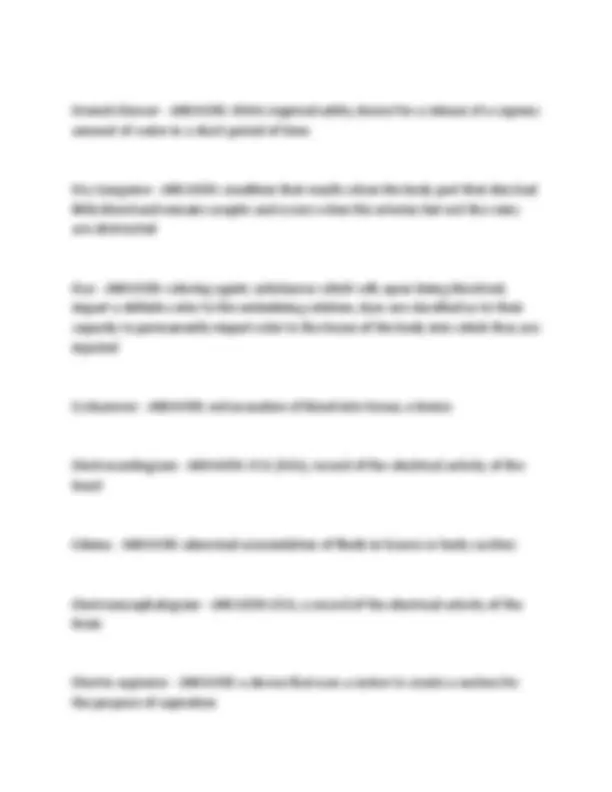
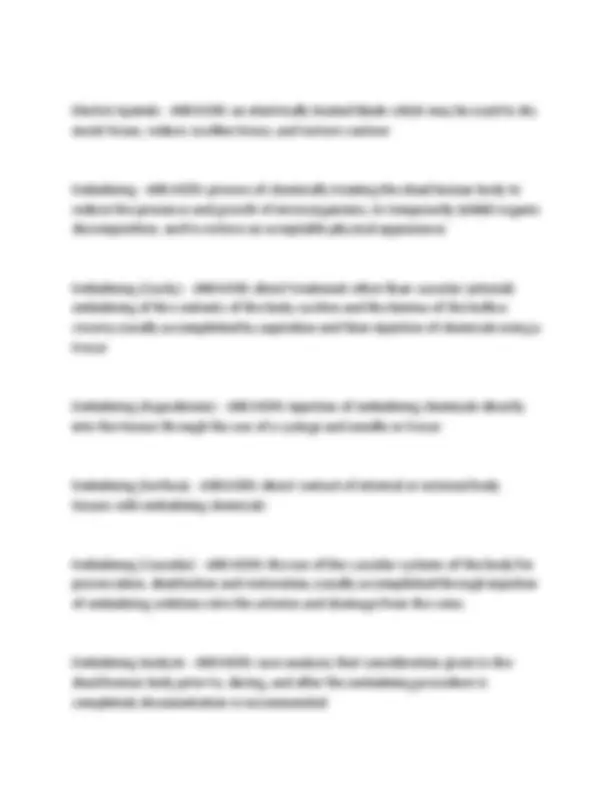
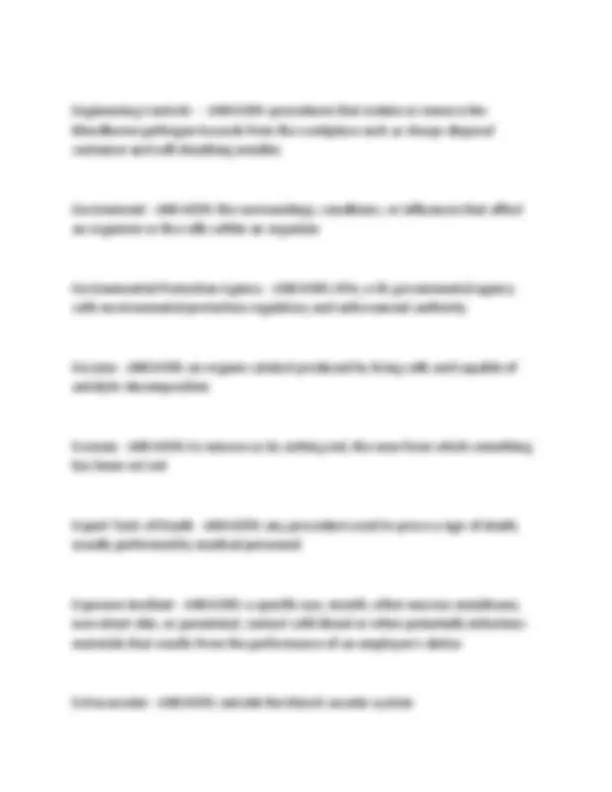
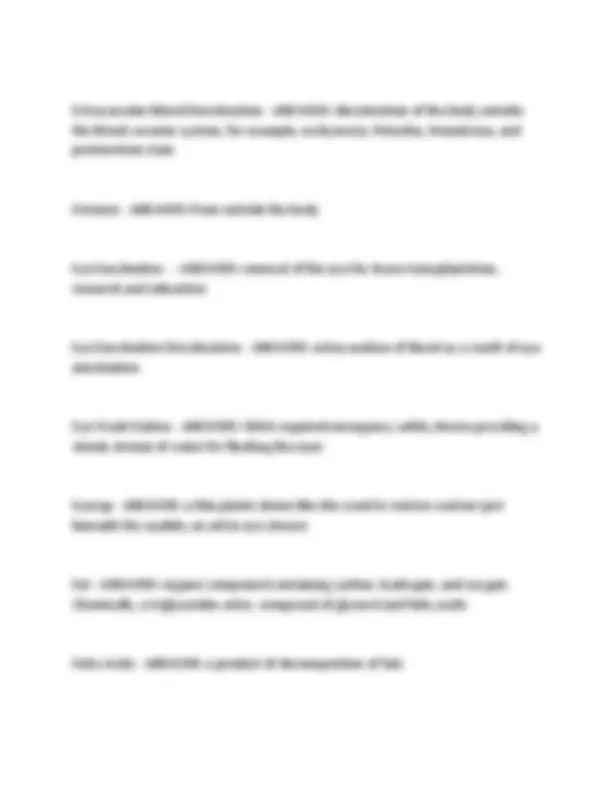
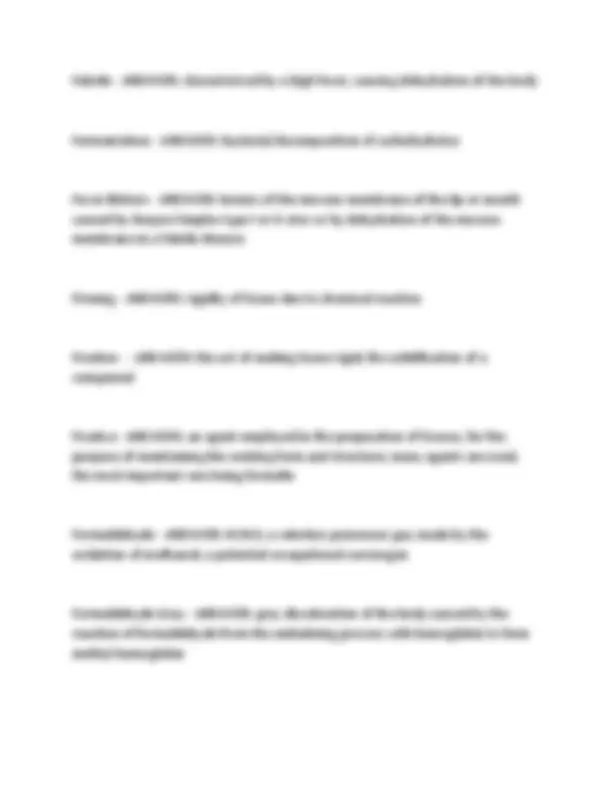
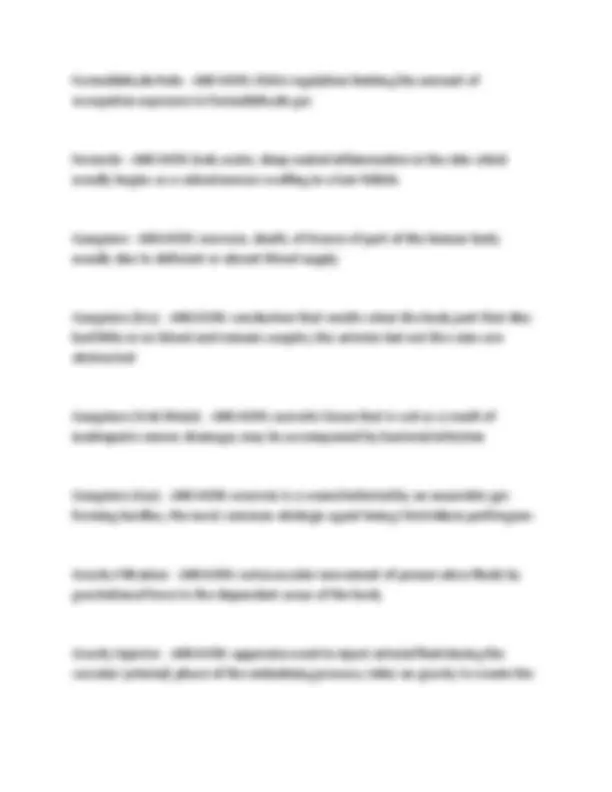
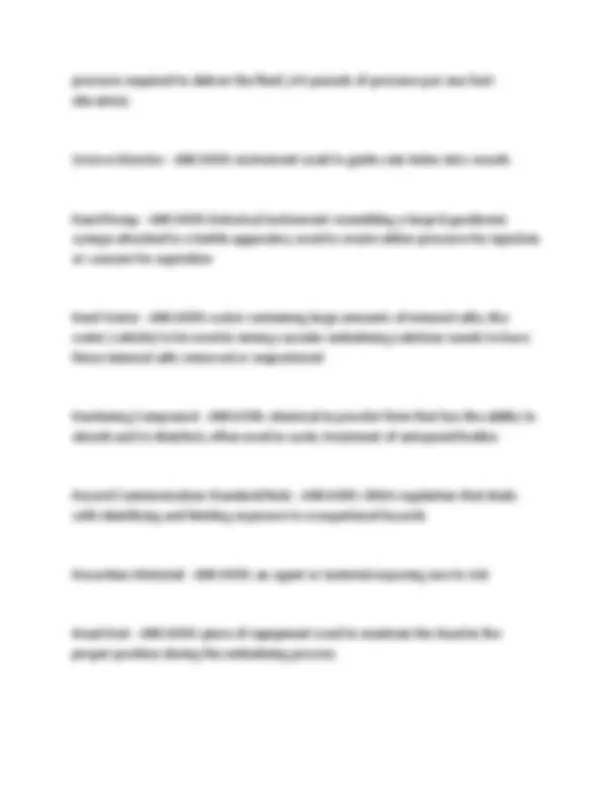
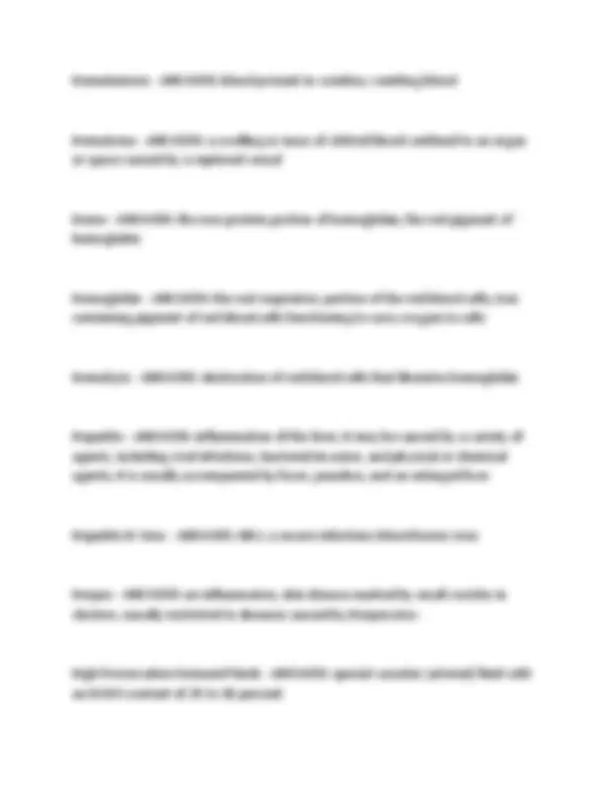
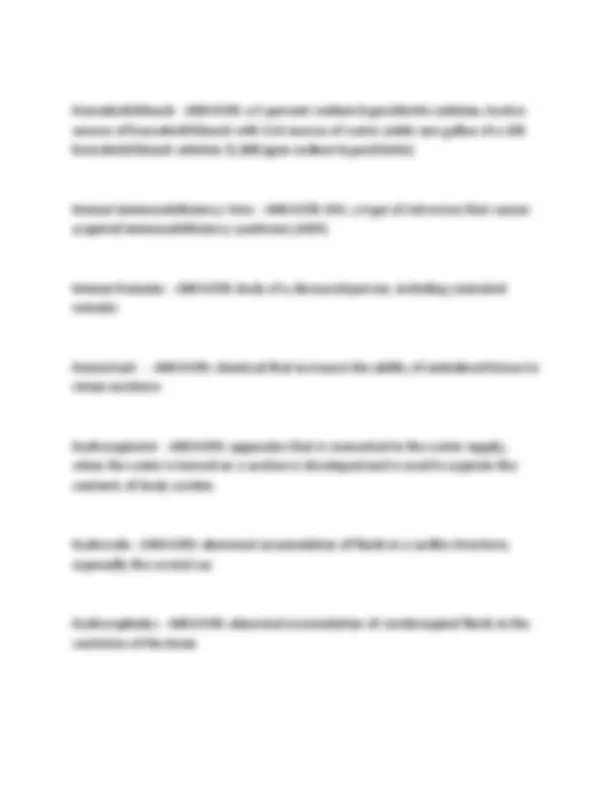
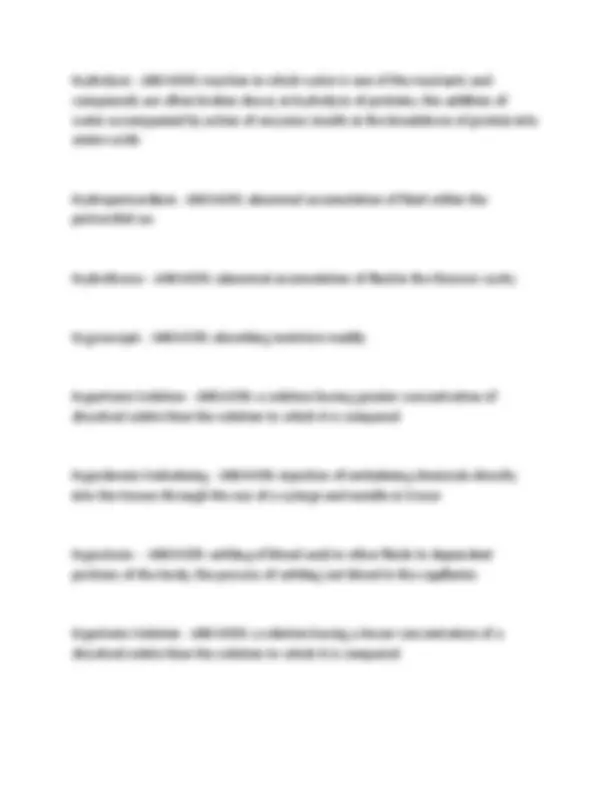
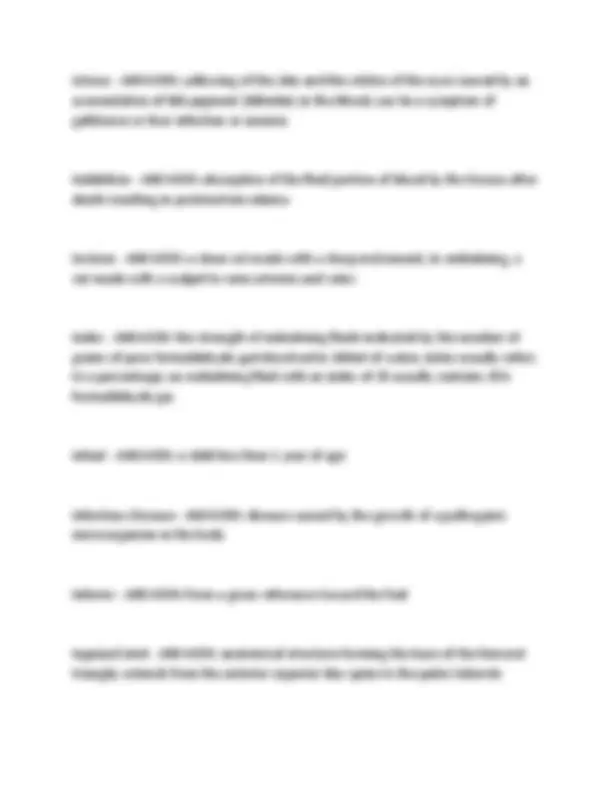
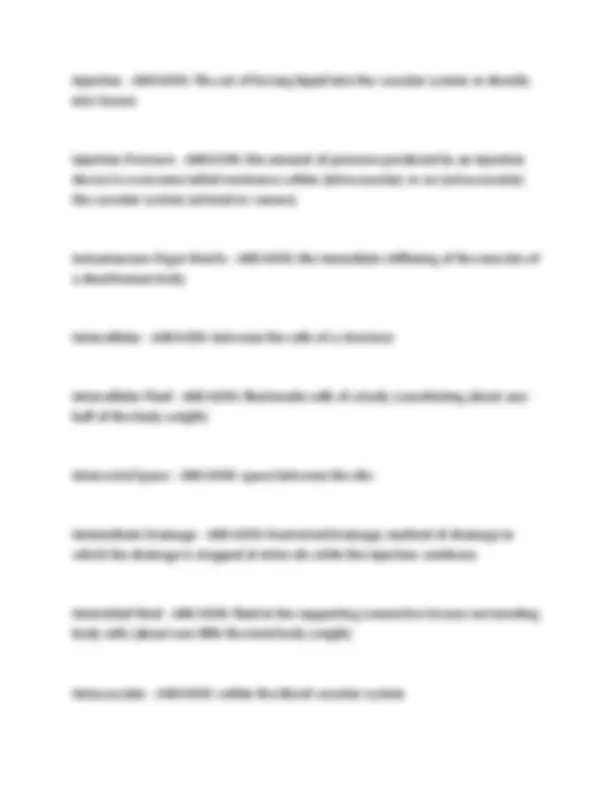
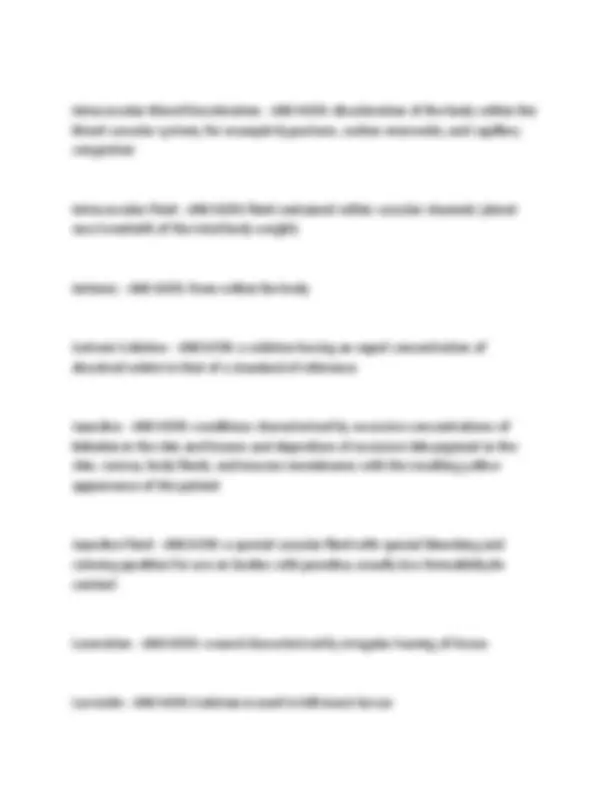
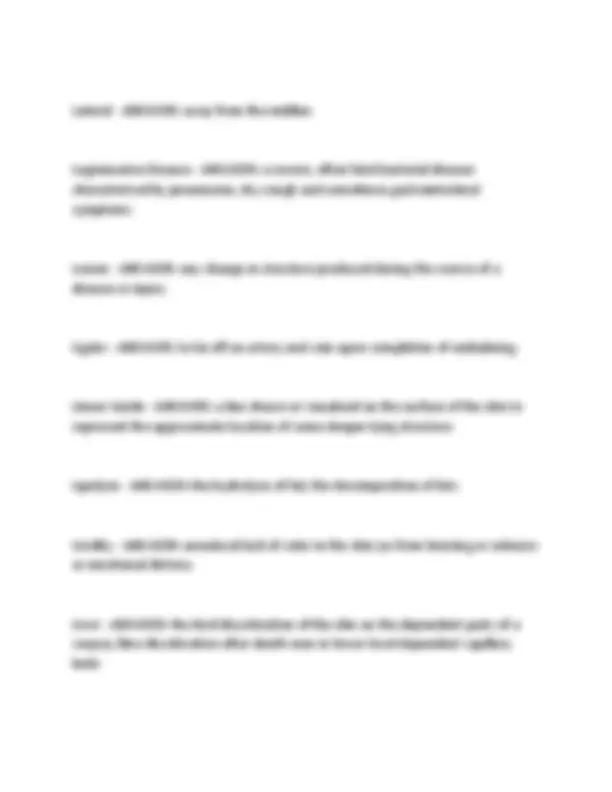
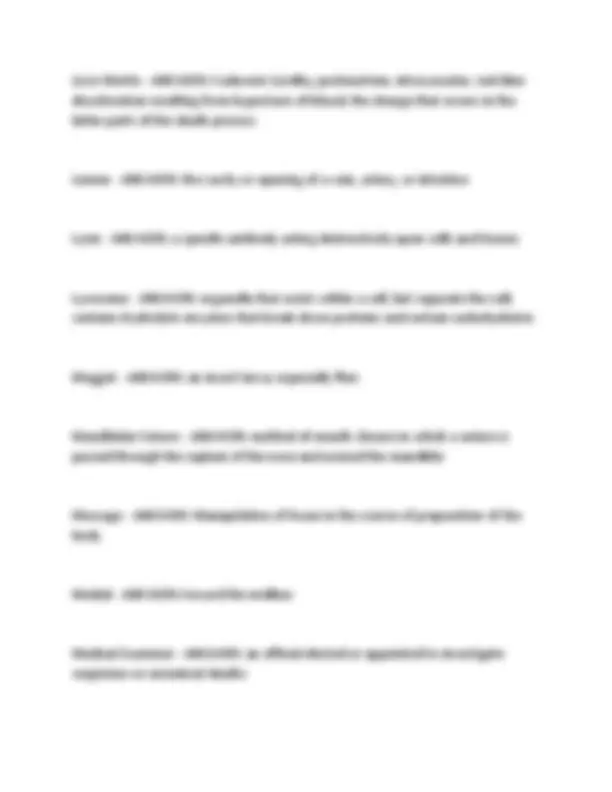
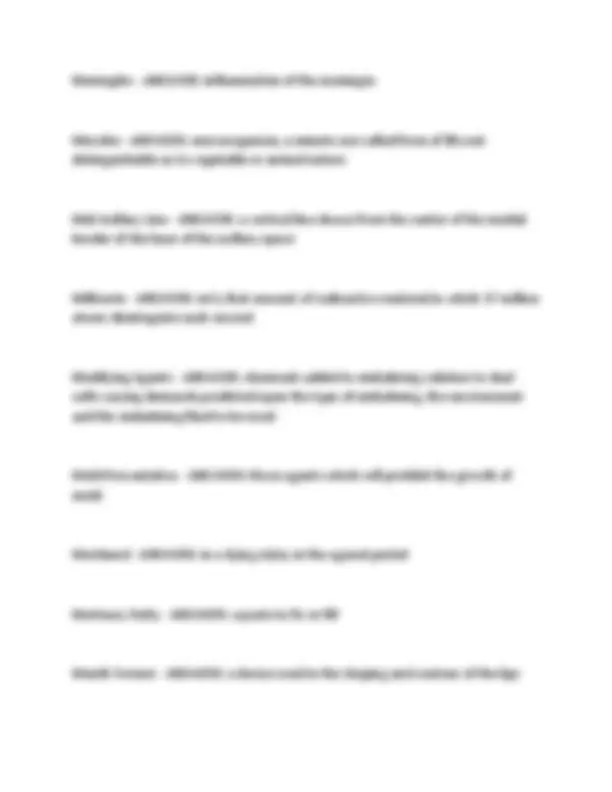
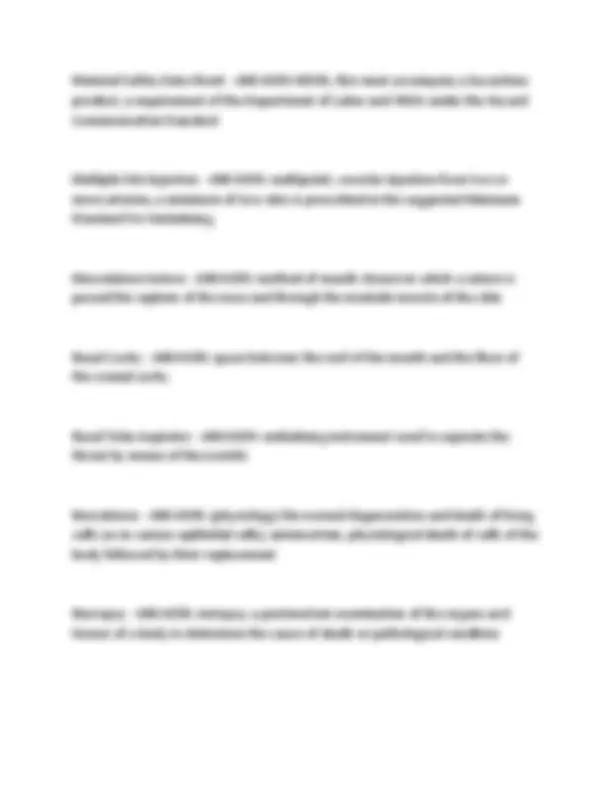
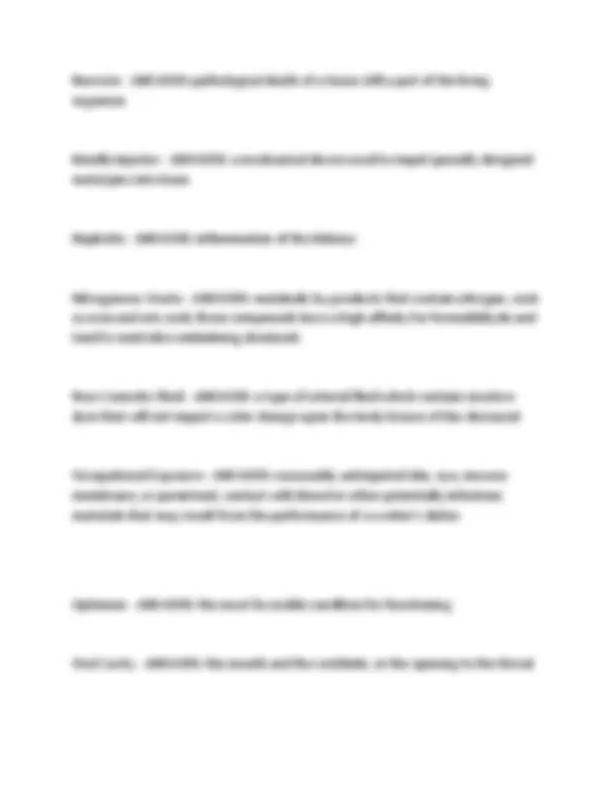
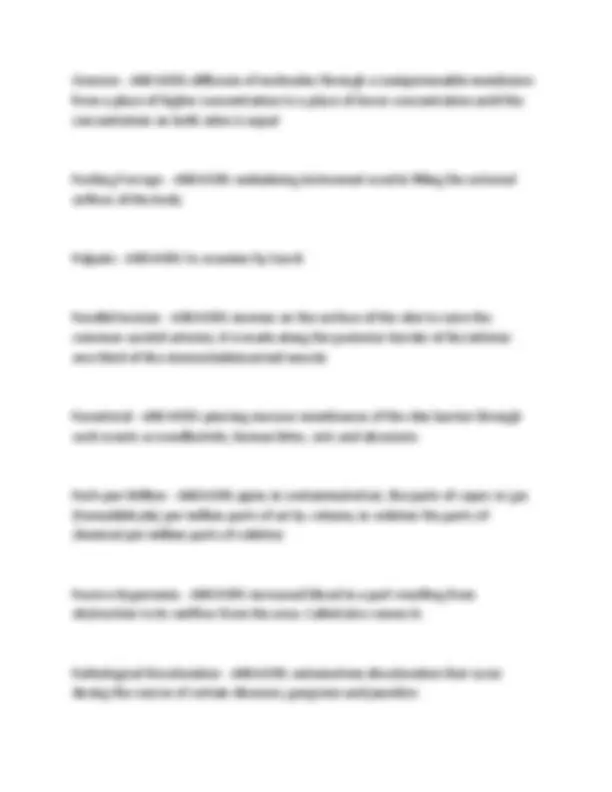
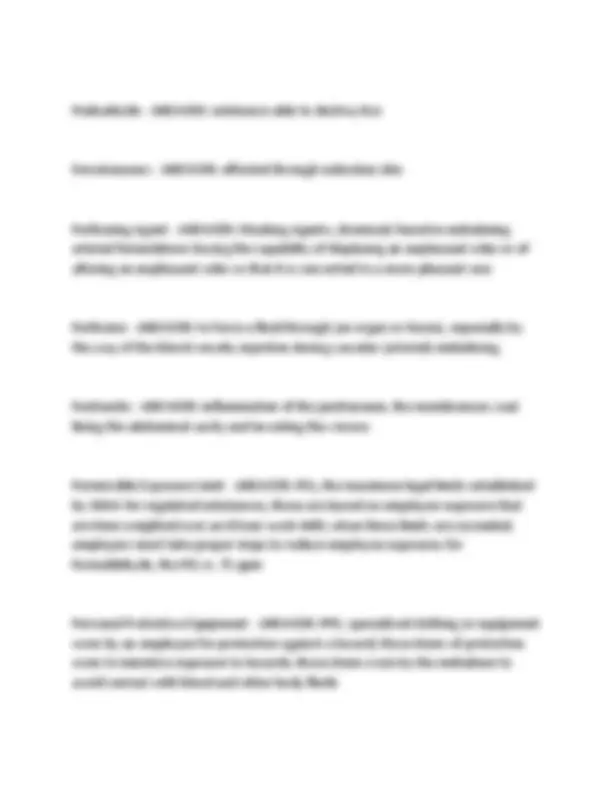
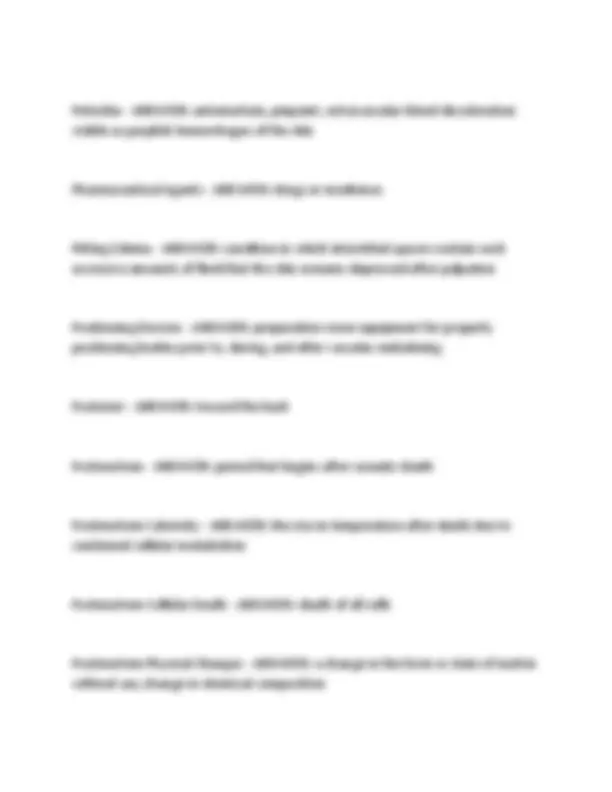
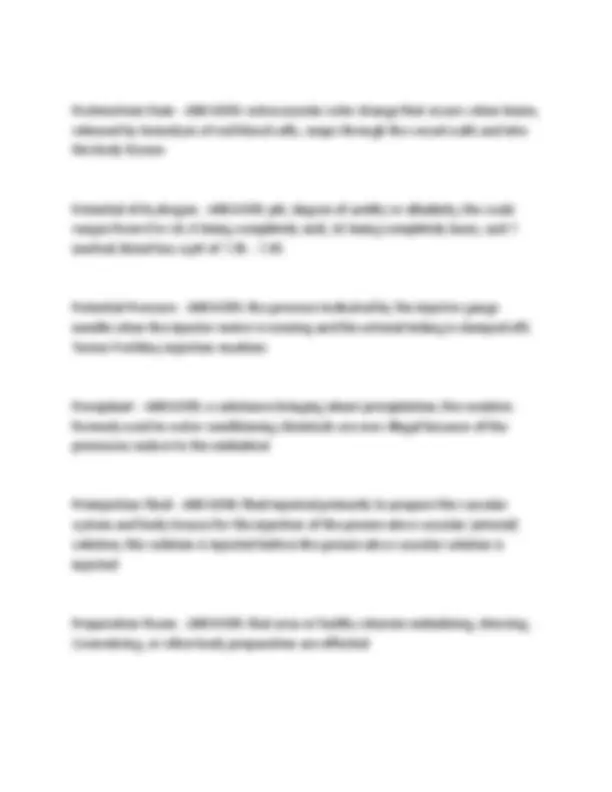
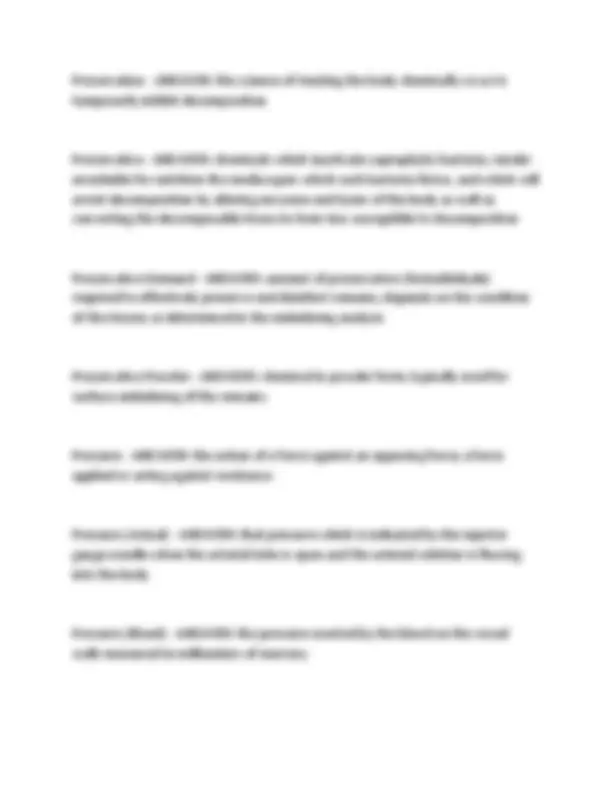
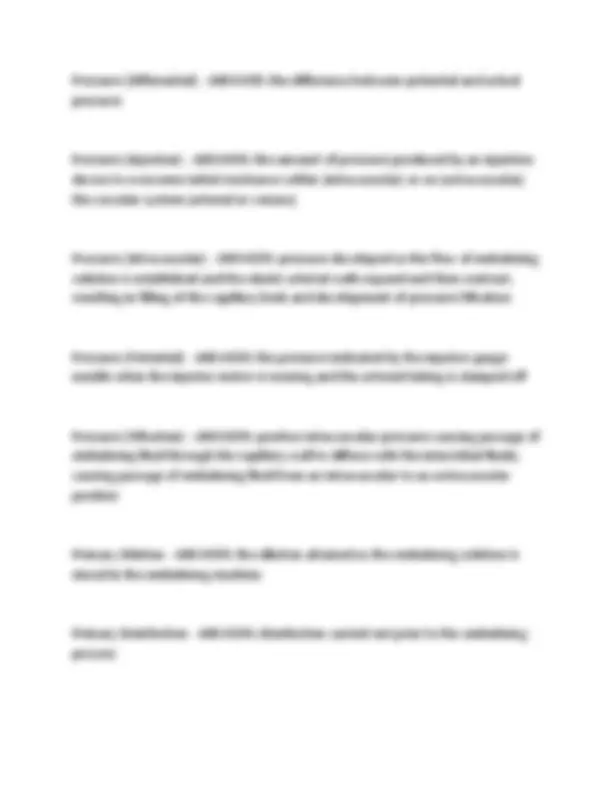
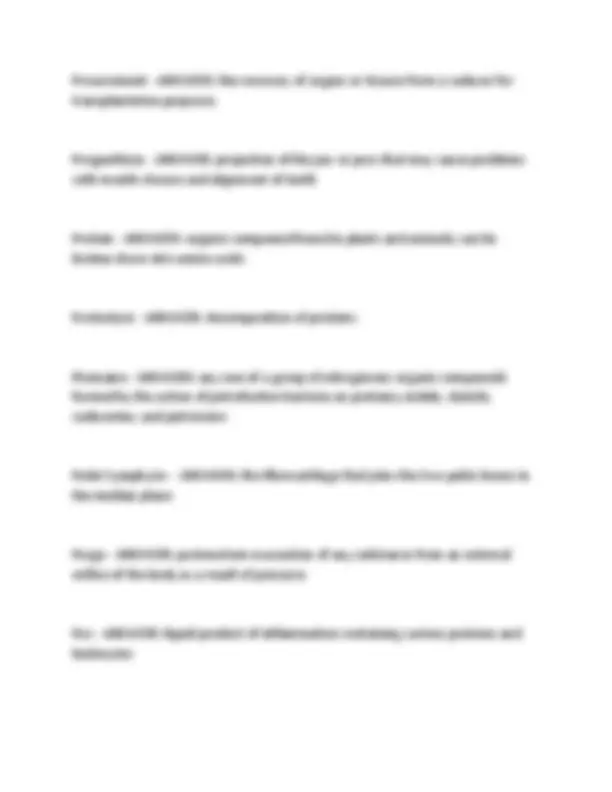
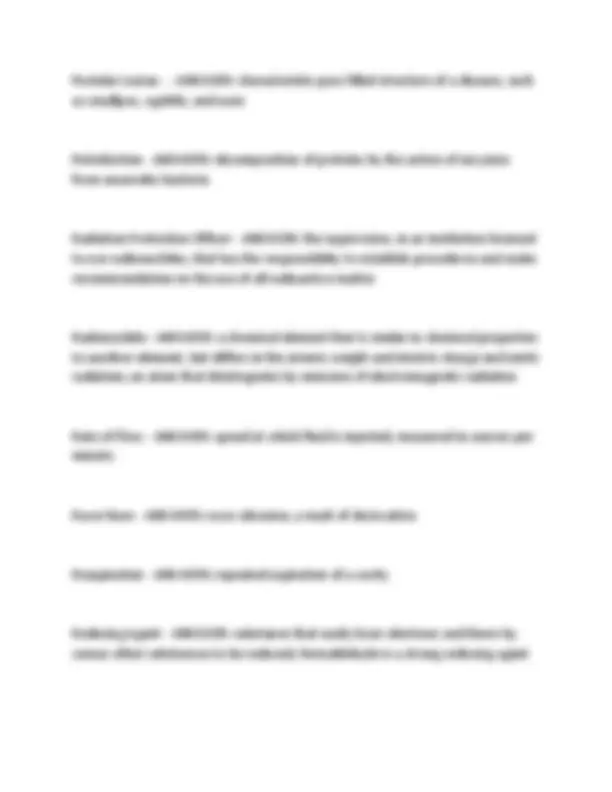
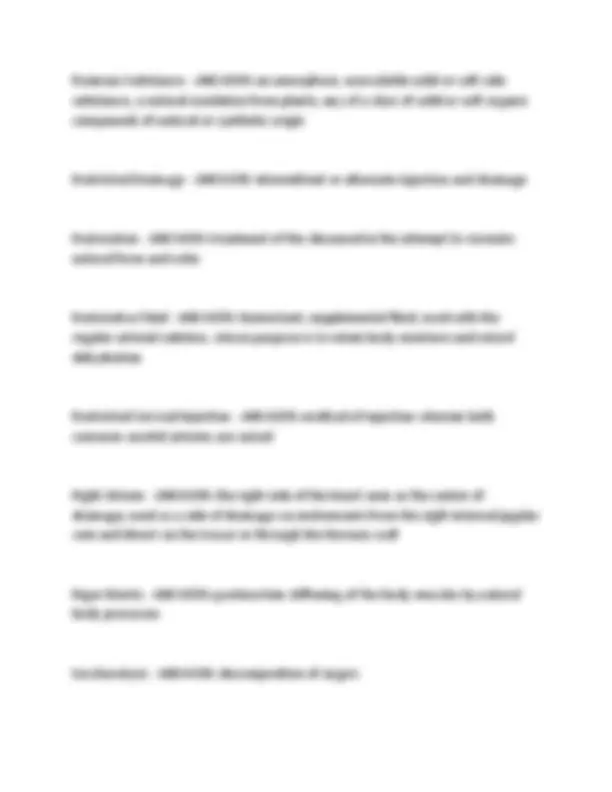
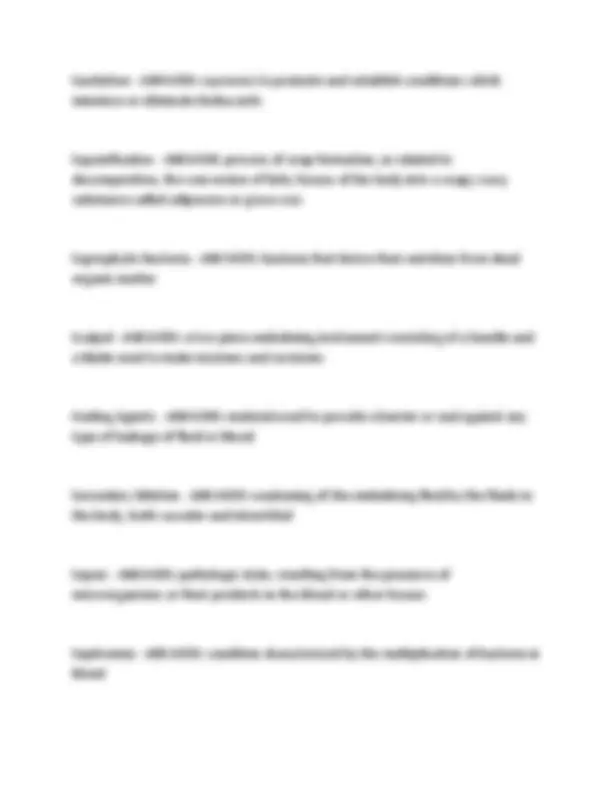
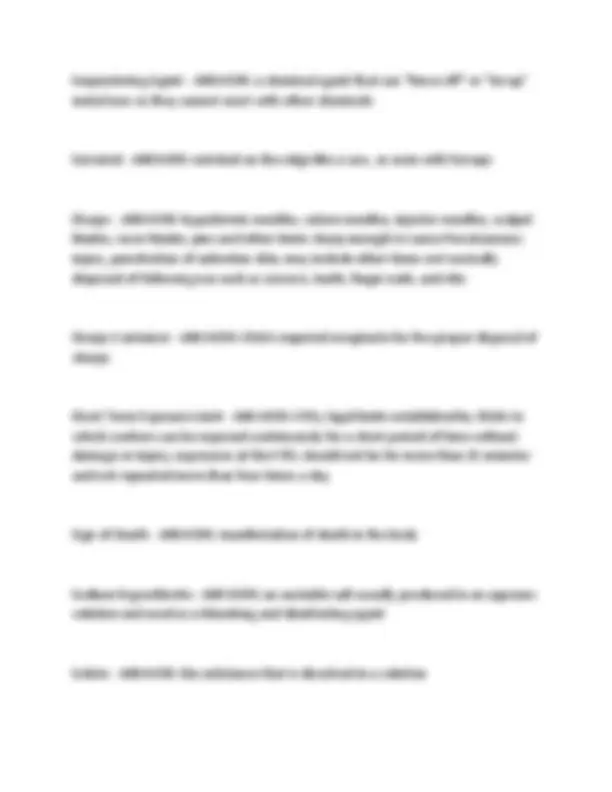
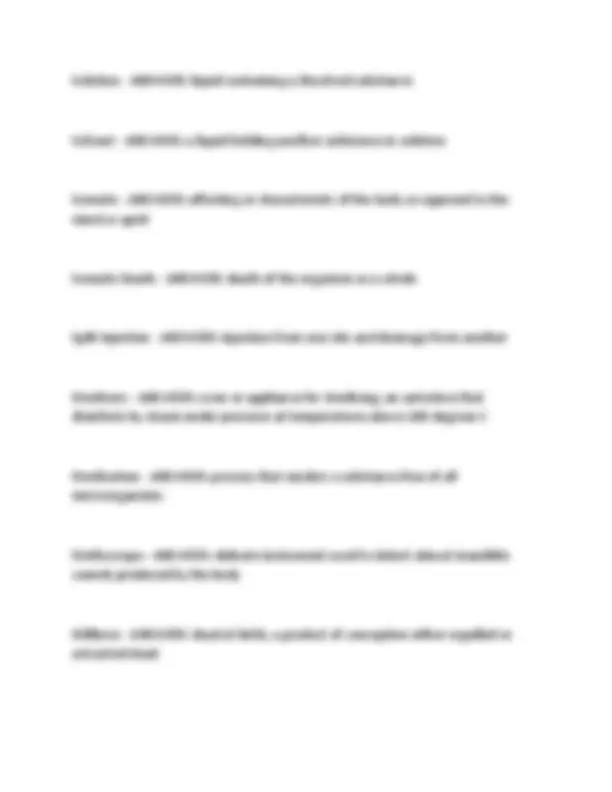
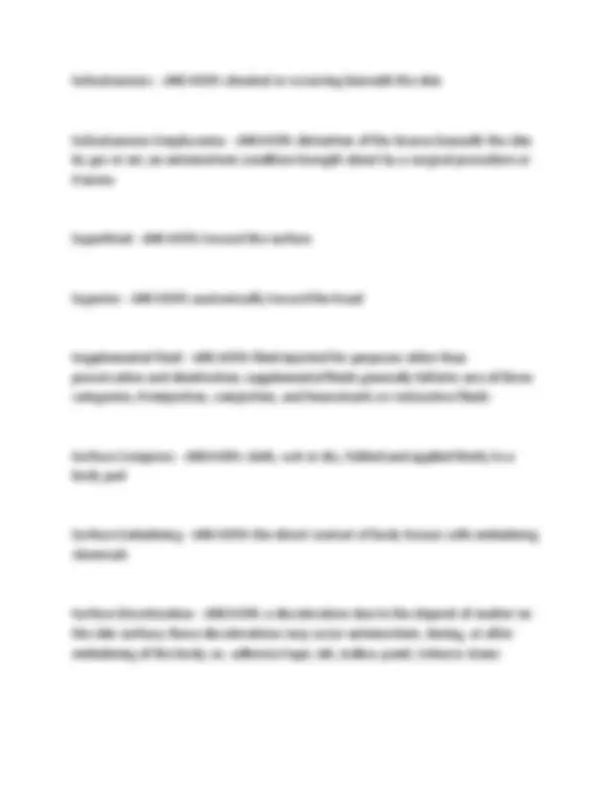

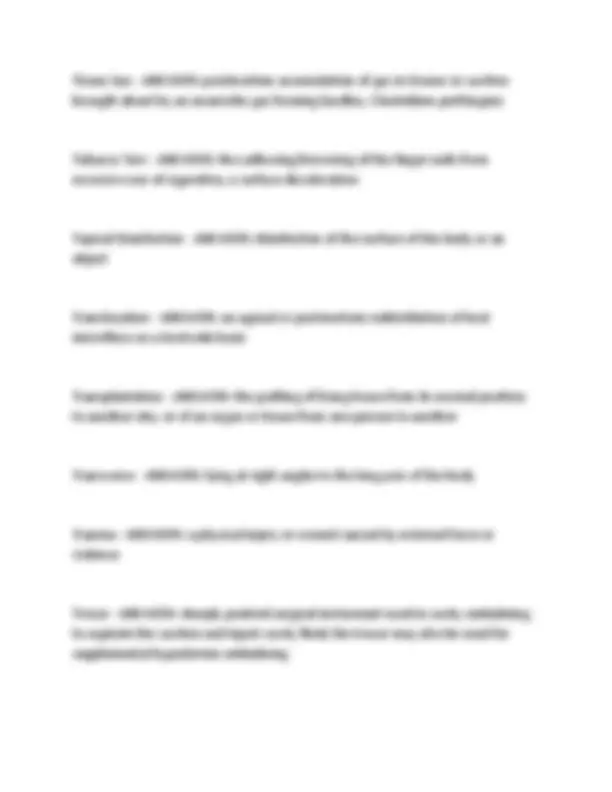
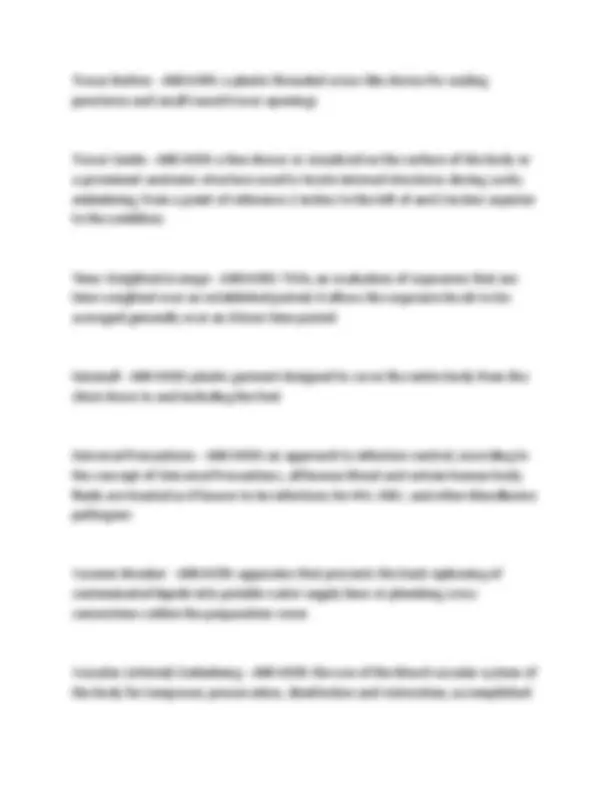
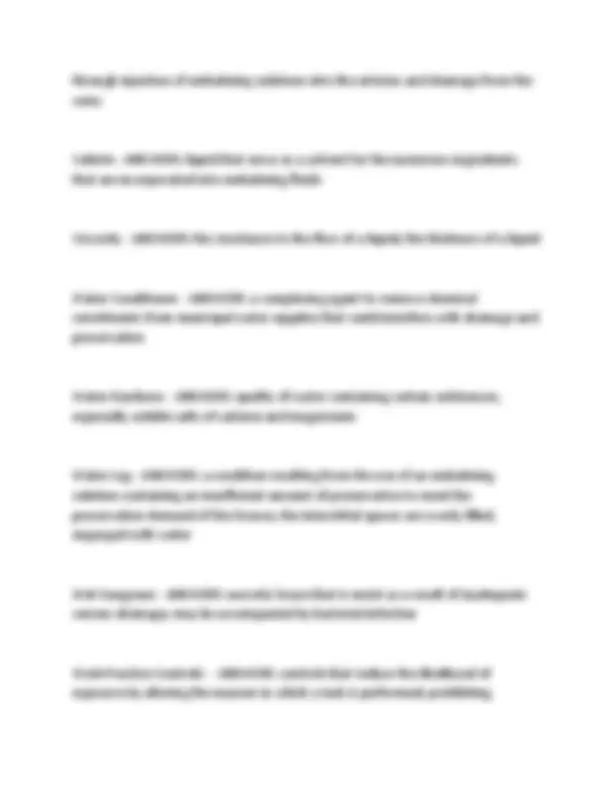



Study with the several resources on Docsity

Earn points by helping other students or get them with a premium plan


Prepare for your exams
Study with the several resources on Docsity

Earn points to download
Earn points by helping other students or get them with a premium plan
Community
Ask the community for help and clear up your study doubts
Discover the best universities in your country according to Docsity users
Free resources
Download our free guides on studying techniques, anxiety management strategies, and thesis advice from Docsity tutors
A comprehensive list of questions and answers related to embalming practices, covering key concepts and procedures. It offers insights into the field of mortuary science, including topics like osha regulations, injection techniques, and anatomical terminology. A valuable resource for students and professionals seeking to understand the fundamentals of embalming.
Typology: Exams
1 / 58

This page cannot be seen from the preview
Don't miss anything!



















































Occupational Safety and Health Administration - ANSWERS-OSHA; a Governmental Agency with the responsibility for regulatory and enforcement of safety and health matters for most United States employees; an individual State OSHA agency may supercede the US Department of Labor OSHA regulations
One Point Injection - ANSWERS-injection and drainage from one location
Operative Corrections - ANSWERS-any and all techniques to treat a problem area; excision, incision, wicking
Ophthalmoscope - ANSWERS-an optical instrument with an accompanying light that makes it possible to examine the retina and to explore for blood circulation
Action Level AL - ANSWERS-Exposure Limits; these levels are established to ensure adequate protection of employees at exposures below the OSHA limits, but to minimize the compliance burdens for employers whose employees have exposures below the 8 hour permissible exposure limit (PEL). The AL for formaldehyde is 0.5 ppm
Active Hyperemia - ANSWERS-hyperemia due to an increased afflux of arterial blood into dilated capillaries
Actual Pressure - ANSWERS-that pressure which is indicated by the injector gauge needle when the arterial tube is open and the arterial solution is flowing into the body
Adipocere - ANSWERS-grave wax; soft whitish crumbly or greasy material that forms upon the postmortem hydrolysis and hydrogenation of body fats
Aerobic - ANSWERS-in the presence of free oxygen
Aerosolization - ANSWERS-to disperse as an aerosol; minute particles of blood and water become atomized and suspended in air when water under pressure meets the blood drainage or when flushing an uncovered sink
Agglutination - ANSWERS-intravascular; the increase of viscosity of blood brought about by the clumping of particulate formed elements in the blood vessels
Algor Mortis - ANSWERS-post mortem cooling of the body to the surrounding temperature
Abdominal Anatomical Regions - ANSWERS-Nine region plan: by means of four imaginary planes, two of which are horizontal (indicated by lines drawn across the right and left 10th ribs and across the right and left anterior superior iliac spines) and two sagittal (indicated by lines drawn from mid point of inguinal ligament to the nipples of the chest, right and left sides. Upper row - right hypochondriac, epigastric, left hypochondriac. Middle row - right lateral, umbilical, left lateral. Lower row - right inguinal, pubic, left inguinal. Four Region Plan: by means of two imaginary planes, one horizontal and the other mid-sagittal. Upper right quadrant, upper left quadrant, lower right quadrant, lower left quadrant
Abrasion - ANSWERS-antemortem injuries resulting from friction of the skin against a firm object resulting in the removal of the epidermis
Abut - ANSWERS-to touch or contact as with the tarsal plates of the closed eyes
Accessory Chemical - ANSWERS-group of chemicals used in addition to vascular (arterial) and cavity embalming fluids; includes but is not limited to hardening compounds, preservative powders, sealing agents, mold preservative agents, and pack application agents
Acquired Immune Deficiency Syndrome - ANSWERS-AIDS; a specific group of diseases or conditions which are indicative of severe Immunosuppression related to infection with the human immunodeficiency virus (HIV); persons dead having had AIDS may exhibit conditions such as wasting syndrome, extrapulmonary tuberculosis, and Kaposi's sarcoma
Alternate Drainage - ANSWERS-method of injection-drainage in which embalming solution is injected and then injection is stopped while the drainage is opened
Amino Acid - ANSWERS-building blocks of which proteins are constructed, and the end products of protein digestion or hydrolysis; their basic formula is NH2- CHRCOOH - an amino group, an alpha carbon, any aliphatic or aromatic radical, and a carboxyl group
Anaerobic - ANSWERS-in the absence of free oxygen
Anascara - ANSWERS-severe generalized edema
Anatomical Guide - ANSWERS-a descriptive reference for locating arteries and veins by means of anatomical structures that are known
Anatomical Limits - ANSWERS-points of origin and points of termination in relation to adjacent structures; used to designate the boundaries of arteries
Anatomical Position - ANSWERS-the body is erect, feet together, palms facing forward, and thumbs are pointed away from the body
Anterior Superior Iliac Spine - ANSWERS-a bony protuberance, that can be palpated topographically, found on the ilium, the superior, broad portion of the hipbone; the origin of the inguinal ligament and the sartorius muscle
Anticoagulant Fluid - ANSWERS-ingredient of embalming fluids that retards the natural postmortem tendency of blood to become more viscous or prevents adverse reactions between blood and other embalming chemicals
Apparent Death - ANSWERS-condition in which the manifestations of life are feebly maintained
Arterial (Vascular) Fluid - ANSWERS-the concentrated, preservative, embalming chemical that will be diluted with water to form the arterial solution for injection into the arterial system during vascular embalming; the purpose is for inactivating saprophytic bacteria and rendering the body tissues less susceptible to decomposition
Arterial Solution - ANSWERS-the mixture of arterial (vascular) fluid and water which is used for the arterial injection and may include supplemental fluids
Arterial Tube - - ANSWERS-a tube used to inject embalming fluid into the blood vascular system
Arteriosclerosis - ANSWERS-the term applied to a number of pathological conditions causing a thickening, hardening, and loss of elasticity of the walls of the arteries
Articulation - ANSWERS-place of union between two or more bones
Ascites - ANSWERS-accumulation of serious fluids in the peritoneal cavity
Asepsis - ANSWERS-freedom from infection and from any form of life; sterility
Asphyxia - ANSWERS-insufficient intake of oxygen resulting from numerous causes
Aspiration - ANSWERS-withdrawal of gas, fluids and semi-solids from body cavities and hollow viscera by means of suction with an aspirator and a trocar
Astringent - ANSWERS-a drug that causes contraction of body tissues and canals
Atheroma - ANSWERS-fatty degeneration or thickening of the walls of the larger arteries occurring in arthosclerosis
Audition - ANSWERS-the ability to hear; the auditory faculty
Autoclave - ANSWERS-apparatus used for sterilization by steam pressure, usually at 250 F / 121 C for a specific time
(Medial) Boundary - ANSWERS-established by drawing a line which connects the two points where the pectoralis major and latissimus dorsi muscles blend into the chest wall
(Lateral) Boundary - ANSWERS-established by drawing a line which connects the two points where the pectoralis major and latissimus dorsi muscles blend into the arm
Bischloromethyl Ether BCME - ANSWERS-a carcinogen potentially produced when formaldehyde and sodium hypochlorite come into contact with each other; normally occurs only in a controlled laboratory setting and requires a catalyst
Biohazard - ANSWERS-biological agent or condition that constitutes a hazard to humans
Biological Death- - ANSWERS-irreversible somatic death
Bleaching Agent - ANSWERS-a chemical which lightens a skin discoloration
Blood - ANSWERS-tissue that circulates through the vascular system and is composed of approximately 22% solids and 78% water
Blood Pressure - ANSWERS-the pressure exerted by the blood in the living body on the arterial wall measured in millimeters of mercury
Bloodborne Pathogen Rule - ANSWERS-OSHA REGULATION (29CFR 1910-1030) regulating the employee's exposure to blood and other body fluids. OSHA DEFINITIONS: Blood. Human blood, human blood components, and products made from human blood
Bloodborne Pathogens - ANSWERS-pathogenic microorganisms that are present in human blood and can cause disease in humans; these pathogens include, but are not limited to, hepatitis B virus (HBV) and human immunodeficiency virus (HIV)
Contaminated - ANSWERS-the presence or the reasonably anticipated presence of blood or other potentially infectious materials on an item or surface
Contaminated Laundry - ANSWERS-laundry which has been soiled with blood or other potentially infectious materials or may contain sharps
Contaminated Sharps - ANSWERS-any contaminated object that can penetrate the skin including, but not limited to, needles scalpels, broken glass, and exposed wire ends
Engineering Controls - ANSWERS-controls (e.g. sharps disposal container, self sheathing needles) that isolate or remove the Bloodborne pathogen hazard from the workplace
Blood Vascular System - ANSWERS-circulatory network composed of the heart, arteries, arterioles, capillaries, venules, and veins
Bloodborne Pathogens - ANSWERS-pathogenic microorganisms that are present in human blood and can cause disease in humans
Blunt Dissection - ANSWERS-the separation and pushing aside of the superficial fascia leading to blood vessels and then the deep fascia surrounding the blood vessels, utilizing manual techniques or round ended instruments which separate rather than cut the protective tissues
Boil - ANSWERS-acute, deep-seated inflammation in the skin which usually begins as a subcutaneous swelling in a hair follicle
Bridge Suture - ANSWERS-Temporary Interrupted Suture; individual stitch knotted at the tissue edge; maybe applied prior to embalming to align tissues
Buccal Cavity- - ANSWERS-vestibule of the oral cavity; the space between the lips, gums, and teeth
Bulb Syringe - ANSWERS-self-contained, soft rubber manual pump designed to create pressure to deliver fluid as it passes through one-way valves located within the bulb; it is used to deliver fluids; it cannot be used for aspiration
Buffers - ANSWERS-an embalming chemical which affects the stabilization of the acid-base (ph) balance within the solutions and in the embalmed tissues
Cadaver - ANSWERS-dead human body used for medical purposes; including transplantation, anatomical dissection, and study
Cadaveric Lividity - ANSWERS-Livor Mortis; postmortem, intravascular, red-blue discoloration resulting from hypostasis of the blood
Cadaveric Spasm - ANSWERS-a prolongation of the last violent contraction of the muscles into the rigidity of death; instantaneous rigor mortis
Calvarium - ANSWERS-the dome-like superior portion of the cranium; that portion removed during the cranial autopsy
Calvarium Clamp - ANSWERS-a device used as a means of fastening the Calvarium after a cranial autopsy
Canalization - ANSWERS-formation of new channels in tissue
Capillaries - ANSWERS-minute blood vessels, the walls of which comprise a single layer of endothelial cells; capillaries connect the smallest arteries (arteriole) with the smallest veins (venule) and are where pressure filtration occurs
Cellular Death - ANSWERS-death of the individual cells in the body
Center of Fluid Distribution - ANSWERS-ascending and/or arch of the aorta
Center of Venous Drainage - ANSWERS-right atrium of the heart
Centrifugal Force Machine - ANSWERS-embalming machine that uses an electrical pump to create pressure either pulsating or non-pulsating
Center for Disease Control and Prevention - ANSWERS-CDC, CDCP; a major agency of the US Department of Health and Human Services, with headquarters in Atlanta, Georgia, concerned withal phases of control of communicable, vector borne, and occupational diseases
Chelate - ANSWERS-substances that bind metallic ions such as EDTA (Ethylenediamine-tetracetic acid)- used as an anticoagulant in embalming solutions
Chemical Postmortem Change - ANSWERS-a change in the body's chemical composition that occurs after death such as hemolysis
Chemotherapy - ANSWERS-the application of chemical reagents in the treatment of disease in man, causing an elevated preservation demand
Clostridium perfringens - ANSWERS-anaerobic Gram-positive rod bacterium that produces epsilon toxin; can be used as a bioweapon; A type of bacteria that is the most common agent of gas gangrene and can also cause food poisoning as well as a fulminant form of bowel disease called necrotizing colitis
Clinical Death - ANSWERS-a phase of somatic death lasting from 5-6 minutes in which life may be restored
Coagulating Agents - ANSWERS-chemical and physical agents that bring about coagulation
Coagulation - ANSWERS-the process of converting soluble protein into insoluble protein by heating or contact with a chemical such as an alcohol or an aldehyde; the solidification of a sol into a gelatinous mass; agglutination is a specific form of coagulation
Coinjection Fluid - ANSWERS-a fluid used primarily to supplement and enhance the action of vascular (arterial) solutions
Coma - ANSWERS-the irreversible cessation of brain activity and loss of consciousness; death beginning at the brain
Communicable Disease - ANSWERS-disease that may be transmitted either directly or indirectly between individuals by an infectious agent
Coroner - ANSWERS-an official of a local community who holds inquests concerning sudden, violent, and unexplained deaths
Corpulence - ANSWERS-obesity; having an abnormal amount of fat on the body
Cosmetic Fluid - ANSWERS-embalming fluid that contains dyes and coloring agents intended to restore a more natural skin tone through the embalming process
Counter Staining Compound- - ANSWERS-dye that helps to cover internal discolorations such as jaundice
Coverall - ANSWERS-plastic garment designed to cover the body from the chest down to the upper thigh
Cranial Embalming - ANSWERS-method used to embalm the contents of the cranial cavity through aspiration and injection of the cranial chamber by passage of a trocar through the cribriform plate
Cremated Remains - ANSWERS-those elements remaining after cremation of a dead human body
Crepitation - ANSWERS-crackling sensation produced when gasses trapped in tissues are palpated, as in subcutaneous emphysema
Creutzfeldt-Jacob Disease - ANSWERS-a disease of the central nervous system with unknown etiology, assumed to be a slow virus; because of unknown etiology, care givers using invasive procedures use extreme caution
Cribriform Plate - ANSWERS-thin, medial portion of the ethmoid bone of the skull
Cyanosis - ANSWERS-a bluish discoloration of the skin and mucous membranes; a sign that oxygen in the blood is dangerously diminished (as in carbon monoxide poisoning)
Death - ANSWERS-irreversible cessation of all vital functions; (nonlegal definition)
Death Rattle - ANSWERS-noise made by a moribund person caused by air passing through a residue of mucous in the trachea and posterior oral cavity
Death Struggle - ANSWERS-the semi-convulsive twitches which often occur before death
Decay - ANSWERS-composition of proteins by enzymes of aerobic bacteria; aerobic proteolysis
ecomposition - ANSWERS-separation of compounds into simpler substances by the action of microbial and/or autolytic enzymes